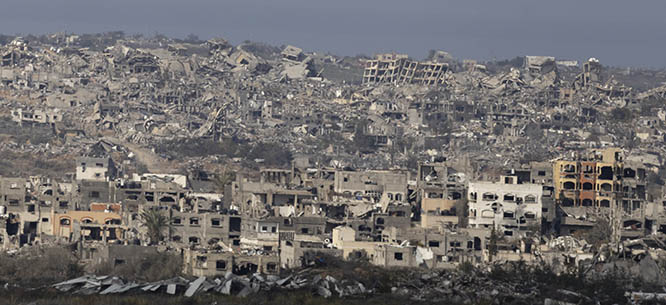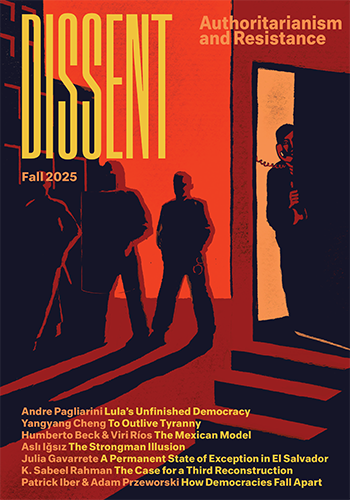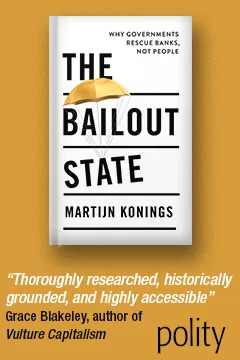A Fragile Ceasefire in Gaza
A Fragile Ceasefire in Gaza
The chances for durable peace may depend on Trump’s whims.

On Sunday, after a delay of several hours, the long-hoped-for ceasefire agreement between Israel and Hamas finally went into effect. At around 5:00 p.m. in Gaza City, uniformed Hamas militants appeared in Saraya Square to initiate the transfer of three female Israeli hostages—Romi Gonen, Doron Steinbrecher, and Emily Damari—to the hands of the Red Cross, and then on to Israel. In the plaza dubbed “Hostages Square” in central Tel Aviv, a crowd stood in electric silence, watching the scene unfold on a large-screen TV. Meanwhile, in the occupied West Bank, the Israel Prison Service began preparing for the release of ninety Palestinian female and child prisoners that night, among them Khalida Jarrar, a leading member of the Popular Front for the Liberation of Palestine, and Shatha Jarabaa, a twenty-four-year-old from Ramallah arrested for social media posts. In Gaza, millions of Palestinians displaced during Israel’s catastrophic assault started the journey back to the ruins of their homes to search for the remains of loved ones beneath the rubble, accompanied by the persistent hum of Israeli drones.
The agreement is to unfold in three phases. In the first six-week phase, Israel will withdraw its forces from the heart of the devastated territory to the kilometer-wide buffer zone near the separation barrier, established through the systematic demolition of Palestinian houses. In exchange for thirty-three hostages held by Hamas—children, women, the elderly, and the injured—Israel will release more than 1,000 Palestinians (thirty Palestinian detainees for each civilian, and fifty Palestinians for each female soldier). As the first phase proceeds, the two sides will begin negotiating the subsequent two phases, during which the remaining Israeli hostages, alive and dead, will be released and Israeli troops will withdraw fully from the strip.
There is no guarantee that these stages will happen. Prime Minister Benjamin Netanyahu reportedly promised his right-wing coalition partners that Israel would restart the war and gradually assert full control over the strip. Whether the ceasefire prevails therefore depends on the newly inaugurated President Donald Trump. It is not a comforting thought. Asked during a press conference on Monday if he thought the ceasefire would hold, Trump responded, “I’m not confident.” Yet he managed to do what Joe Biden could not and halt the carnage that rent the fabric of life in Gaza for almost a year and a half. The durability of the ceasefire will thus be a test not only of the new administration’s Middle East policy, but also of the world order taking shape around the figure of Trump and the new rules of the game his reelection seems to presage.
Beneath the joy of Israeli hostages rejoining their families and Gazans celebrating an end to the bombardment is a deep sense of grief. The current ceasefire agreement is barely different from the one that has been on the table since last spring. That it went unsigned was due to a combination of Netanyahu’s lethal intransigence and U.S. Secretary of State Antony Blinken’s shameful fecklessness. Netanyahu, whose primary concern throughout the last 470 days has been his political survival—to remain in power and avoid his ongoing corruption trial—would not risk fracturing his hard-right government, given his coalition partners’ adamant opposition to any halt in the fighting and their messianic aspirations to reoccupy and resettle the Gaza Strip. Blinken, for his part, like many in the Biden administration, appeared to lack the will needed to exert any serious pressure on Netanyahu. If Biden’s triumphal remarks about the “changed regional equation” in his address last Wednesday are any indication, his administration may have also considered the continuation of Israel’s brutal campaign in Gaza conducive to achieving its larger geopolitical aims. The war did not end sooner because the Biden administration did not insist that it needed to.
The costs of this intentional delay were catastrophic—and we may only grasp their true magnitude with time. In the months since the ceasefire deal was first put on the table, Israeli airstrikes, artillery, and armored troops and infantry killed thousands more Palestinians. Through the fall, Israeli forces besieged the northern part of the Gaza Strip, demolishing the structures that survived the prior aerial campaign, eliminating vital life-sustaining infrastructure, and forcing hundreds of thousands of Palestinians from their homes in a campaign of ethnic cleansing that was openly and repeatedly described by Israeli officials as such. In August, Hamas killed several Israeli hostages, among them Hersh Goldberg-Polin, whose parents Rachel and Jon appeared on stage at the Democratic National Convention to plead for his release, and whose name was on the list of Israeli hostages who would have been freed in the first phase of a deal. At least half a dozen hostages and an untold number of innocent human beings in Gaza would likely be alive today had the earlier deal been signed. Ultimate responsibility for their deaths rests on the Biden administration and the Netanyahu government.
In this criminal war, Israel has failed strategically as well as morally. In the aftermath of October 7, Netanyahu announced war aims widely acknowledged to be mutually exclusive: the return of all 250 Israeli hostages and the complete overthrow of Hamas in Gaza. Israel achieved neither. Netanyahu and the entire Likud-aligned media apparatus trumpeted the bellicose slogan that only “military pressure” could bring “total victory.” In reality, it is likely more Israeli hostages were killed by IDF fire than rescued through spectacular special operations. The goal of destroying Hamas was, likewise, spin without substance. Not only because, as IDF spokesman Daniel Hagari acknowledged, “Hamas is an idea,” and therefore would not disappear, no matter how many tons of ordinance Israeli warplanes dropped on Gaza. But also because Netanyahu refused to discuss any political arrangement for “the day after” in Gaza, including possibilities that would have empowered any serious alternative to unitary Hamas rule.
The display of power and determination engineered by Hamas as the ceasefire went into effect telegraphed that the Islamist group is battered but not defeated. Dressed in green uniforms, their faces covered by black balaclavas, Hamas militants paraded through Gaza streets, piled on top of white Hyundai SUVs. Hamas now faces the impossible task of rebuilding a devastated territory, a challenge that will be made more difficult by the reticence of international actors—including the Gulf States and the European Union—to work directly with the group; Trump has insisted that Hamas cannot rule in Gaza over the long-term. In the occupied West Bank, meanwhile, Hamas has garnered significant support since October 7, threatening the stability of the Palestinian Authority’s authoritarian fiefdom. As the bus carrying the Palestinians released by Israel reached the West Bank town of Beitunia, the jubilant crowd assembled to greet them chanted “the people love Al Qassam,” referring to Hamas’s armed wing. The risk of a new conflagration in the West Bank has increased. On Monday night, radical Israeli settlers rioted in the West Bank in protest against the ceasefire, torching homes and cars in the Palestinian village of Jinsafut. The following day the IDF announced a new “large-scale and significant military operation” in the northern West Bank, unleashing a new round of deadly raids in the city of Jenin.
For all the talk in Israel that October 7 shattered the “conceptzia”—the paradigm of perpetual occupation management perfected by successive Netanyahu administrations—it has prevailed. After the deadliest and most destructive year and a half in the history of the Israeli-Palestinian conflict, the basic political reality has changed little from what it was on October 6, 2023. Hamas continues to be the unchallenged governing power in the Gaza Strip. The Fatah-led Palestinian Authority maintains its tenuous rule in the occupied West Bank, forced into the role of Israel’s subcontractor, grasping at shreds of legitimacy in the absence of a horizon for future Palestinian sovereignty. The one-state reality of ultimate Israeli control between the Mediterranean Sea and Jordan River persists. As the dust settles, the blood-soaked stasis comes more clearly into view.
Why did Trump appear to succeed where Biden failed? The urgency with which Trump insisted on a deal, and the alacrity with which Trump’s Middle East envoy Steve Witkoff achieved it, took everyone by surprise. Certainly, Netanyahu did not expect this. To the contrary, he had prolonged the war through the U.S. presidential elections in part because he hoped that a second Trump administration would give his government a freer hand than the Biden administration, as if such a thing were possible. We may never know what Witkoff told Netanyahu when he imposed himself on the prime minister at his office on January 11. Perhaps Witkoff’s hard-talking, mafia-style tactics did the trick where Blinken’s effete liberal politesse could not; force is, after all, a language that Netanyahu understands. Or maybe the Trump-Netanyahu dance was more choreographed than coerced. There are other items higher up on Netanyahu’s wish list, and Trump famously loves a deal.
Unlike in 2020, however, annexation of all or part of the occupied West Bank probably will not be on the table. Trump has not forgotten how the Israeli right spurned his 2020 “Deal of the Century,” which green-lighted Israel’s annexation of West Bank settlements in exchange for a nominal Palestinian state in isolated bantustans throughout the territory. For the hardline Israeli settlers, even an ersatz Palestinian state was too much. But there are other areas where U.S. and Israeli interests, as conceived by Trump and Netanyahu, rhyme. On Monday, Trump reversed by executive order the sanctions levied by the Biden administration against a host of settler leaders and organizations over the past year. The Trump administration may, in turn, also sanction the International Criminal Court, which has issued arrest warrants for Netanyahu and former defense minister Yoav Gallant. Trump’s first administration did so in 2020, ostensibly as a response to investigations into U.S. war crimes in Afghanistan, and the new Republican-dominated House of Representatives has already approved legislation to do the same. The pro-settlement Jewish right remains a significant Trump constituency in the United States, even if it is no longer the sole one to which Trump’s Middle East policy must appeal.
Trump’s pre-inauguration push for a ceasefire should not be mistaken for an ideological reversal. He believes, above all, in himself and his own self-interest. If there is to be a pivot away from his first administration’s Middle East policy, which was dedicated to Palestinian humiliation, it is because Trump has apparently fixed in his mind the prospect of winning a Nobel Peace Prize. Figures close to Trump have been intimating that the president wants to strike a grand bargain, building on the Abraham Accords, that would involve a normalization agreement between Israel and Saudi Arabia. The extended Trump clan stands to enjoy substantial financial gain from such a deal. Jared Kushner’s private equity firm reportedly received a $2 billion investment from the Saudi sovereign wealth fund, to say nothing of Trump’s own businesses and those of other figures in the administration like Witkoff, who also boasts lucrative ties to sovereign wealth funds in the Gulf. Rare is the opportunity to construe a windfall as virtuous; for the Trump coterie, it is tantalizing.
There is, however, a major obstacle to Trump’s foreign policy dream: the hardline Israeli right, on which Netanyahu’s current government depends. Any version of the U.S.-Israeli-Saudi deal will require attending to the Palestinians’ aspiration for a state of their own. Saudi Crown Prince Mohammed bin Salman said last September that the Kingdom of Saudi Arabia would not establish diplomatic relations without “an independent Palestinian state with East Jerusalem as its capital,” although behind the scenes he has hinted that he would be satisfied with Israeli commitment to a “pathway to a Palestinian state.” Yet Netanyahu cannot even pay lip-service to Palestinian self-determination without a dramatically different coalition behind him. Many Israeli observers seem to think that Netanyahu, given the choice between keeping the far-right coalition together and a concrete Saudi normalization deal, would opt for the latter. Still, to say that the torrid fantasizing about MBS, Netanyahu, and Trump shaking hands in Riyadh is premature is an understatement. Such an agreement would require the kind of policy focus that Trump has not been known to possess.
If it is true that the much-vaunted international rules-based order lies under the rubble in Gaza, the framework that appears poised to succeed it is not a progressive one. To much of the world, especially the Global South, the Western liberal defenders of the old order often appeared as hypocrites, speaking of values while they pursued their countries’ narrow material interests, usually at the expense of poorer and less powerful countries. With Trump’s reelection and the far right surging in Europe and beyond, the self-appointed guardians of the liberal order are gradually exiting the scene, replaced by the avatars of right-wing kleptocracy. Gone is the talk of values; what remains is naked self-interest. A world ruled by competing global power blocs linked through material gain is, in a way, a less frontally dishonest one. Will it be kinder?
Trump has not suddenly become a friend of Palestine. The fate of Palestinians interests the president insofar as they are now imbricated in his pursuit of personal aggrandizement. The insanity of the current moment means that there is a twinkling chance this reinvigorates the two-state paradigm. Yet as soon as the Palestinians cease to appear useful to Trump, he will not hesitate to cast them aside, leaving them to suffer under the boot of Israel’s relentless occupation. Israelis are in a less precarious position by virtue of the link between the Israeli right and Trumpworld, embodied by figures like Miriam Adelson, widow of the late casino magnate Sheldon Adelson. But they too may find themselves disappointed. Trump has proclaimed many times that he aims to end wars, not start new ones. The Trump administration may be as likely to pursue a new negotiated deal with Iran over its nuclear program, marshalling the threat of a joint U.S.-Israeli operation as leverage, as it is to approve the attack on Iran’s enrichment facilities of which Israeli hawks have long dreamed.
Perhaps most frightening is that for all the global turbulence the second Trump term promises, the catastrophically asymmetrical balance of power on the ground in Israel/Palestine is not likely to change. That is not to say that it cannot change—only that any hope of a better future in the near term requires believing that Trump will be the catalyst for it. Such is the world in which we now live.
Joshua Leifer is the author of Tablets Shattered: The End of an American Jewish Century and the Future of Jewish Life and an editorial board member at Dissent.






